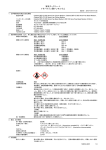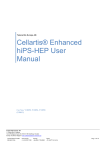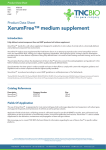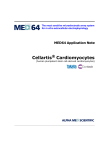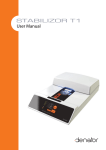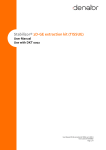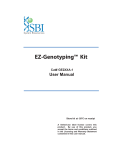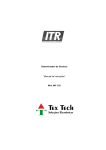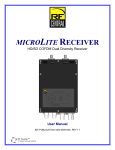Download Cellartis® DEF-CS™ Xeno-Free Culture Medium User Manual
Transcript
Takara Bio Europe AB Cellartis® DEF-CS™ Xeno-Free Culture Medium User Manual Cat. No(s). Y30040 (060115) Takara Bio Europe AB A Takara Bio Company Arvid Wallgrens backe 20, SE-413 46 Göteborg, Sweden Europe Technical Support: [email protected] United States/Canada 800.662.2566 Asia Pacific +1.650.919.7300 Europe +46.(0)31.758.0900 Japan +81.(0)77.543.6116 Page 1 of 9 Cellartis® DEF-CS™ Xeno-Free Culture Medium User Manual Table of Contents I. Introduction ............................................................................................................................................................... 3 II. List of Components ................................................................................................................................................... 3 III. Additional Materials Required .............................................................................................................................. 3 IV. General Considerations ......................................................................................................................................... 3 A. V. Storage and Handling ............................................................................................................................................ 3 Culture of Human iPS Cells in Cellartis DEF-CS Xeno-Free Culture Medium ....................................................... 3 VI. Coating of Cell Culture Vessels ............................................................................................................................ 4 VII. Cellartis DEF-CS Xeno-Free Medium Preparation .............................................................................................. 4 A. Medium for Thawing or Passage of Human iPS Cells.......................................................................................... 4 B. Medium for Maintenance of Human iPS Cells ..................................................................................................... 4 VIII. Passage of Human iPS Cells ................................................................................................................................. 5 A. Preparations........................................................................................................................................................... 5 B. Passage .................................................................................................................................................................. 5 IX. Medium Change of Human iPS Cells ................................................................................................................... 5 A. Preparations........................................................................................................................................................... 5 B. Medium Change .................................................................................................................................................... 5 X. Cryopreservation of Human iPS Cells ...................................................................................................................... 6 XI. Thawing of Human iPS Cells................................................................................................................................ 6 A. Preparations........................................................................................................................................................... 6 B. Thawing Cells ....................................................................................................................................................... 6 XII. Transfer of Human iPS Cells to Cellartis DEF-CS Xeno-Free Culture Medium from Other Culture Media ...... 6 A. Passage interval ..................................................................................................................................................... 7 XIII. Images of Human iPS Cells Maintained in Cellartis DEF-CS Xeno-Free Culture Medium ................................ 7 Appendix A. Troubleshooting Guide ................................................................................................................................ 8 Table of Figures Figure 1 Schematic presentation of the work flow with reference to corresponding section of this user manual in brackets. ............................................................................................................................................................................ 4 Figure 2 Human iPS cells in Cellartis DEF-CS Xeno-Free Culture Medium using Synthemax. Day after passage. ....... 7 Figure 3 Human iPS cells in Cellartis DEF-CS Xeno-Free Culture Medium using Synthemax. Just prior to passage.... 7 Figure 4 Human iPS cells in Cellartis DEF-CS Xeno-Free Culture Medium using iMatrix. Day after passage. ............. 8 Figure 5 Human iPS cells in Cellartis DEF-CS Xeno-Free Culture Medium using iMatrix. Just prior to passage. ......... 8 Table of Tables Table 1 Weekly Schedule ................................................................................................................................................. 4 Table 2. Troubleshooting Guide ....................................................................................................................................... 8 (060115) www.clontech.com Takara Bio Europe AB. A Takara Bio Company Page 2 of 9 Cellartis® DEF-CS™ Xeno-Free Culture Medium User Manual I. Introduction Cellartis® DEF-CS™ Xeno-Free Culture Medium is a chemically defined culture medium of pre-clinical grade, free from human- and animal-derived components, for efficient expansion of undifferentiated human induced pluripotent stem (iPS) cells. All procedures described in the manual are optimised for Cellartis human iPS cell lines. If you wish to use Cellartis DEF-CS Xeno-Free Culture Medium for other human induced pluripotent stem cells, please be aware that procedures and protocols may have to be adjusted. This product should be handled only by persons who have been trained in laboratory techniques and that it is used in accordance with the principles of good cell culture practice. Takara Bio Europe AB recommends the use of media and reagents according to this manual. Takara Bio Europe AB cannot guarantee correct technical feedback on customer cultures unless the below culture instructions have been followed. II. List of Components • • III. Cellartis DEF-CS 500 Xeno-Free Basal Medium (Cat. No Y30041) Cellartis DEF-CS 500 Xeno-Free Additives (Cat. No. Y30042) o DEF-CS Xeno-Free Additive 1 (1000X) (500 µl) o DEF-CS Xeno-Free Additive 2 (1000X) (200 µl) Additional Materials Required The following materials are required but not supplied: • • • • • • IV. Culture substrate: o Corning® Synthemax® II-SC Substrate (Corning, Cat. No. 3535) or o iMatrix-511 (Takara Clontech, Cat. No. T303) PBS Dulbecco's with Ca2+ & Mg2+ (D-PBS +/+) (Life Technologies, Cat. No. 14040) PBS Dulbecco's w/o Ca2+ & Mg2+ (D-PBS -/-) (Life Technologies, Cat. No. 14190) Versene Solution (Life Technologies, Cat. No. 15040) Cell culture vessels, tissue culture treated polystyrene surface General cell culture equipment used in cell culture laboratory General Considerations A. Storage and Handling Cellartis DEF-CS Xeno-Free Basal Medium should be stored at 4˚C and expires according to the label. The Cellartis DEF-CS Xeno-Free Basal Medium formulation contains gentamicin. Cellartis DEF-CS Xeno-Free Additives 1 and 2 should be stored at –20°C and expires according to the label. At first use, thaw provided vials and aliquot into appropriate volumes. Do not vortex. Store at –20°C according to expiry date on original vial. Thawed vials may be stored at 4˚C for up to 1 week. Do not subject the additives to more than a single refreeze and thaw cycle. V. Culture of Human iPS Cells in Cellartis DEF-CS Xeno-Free Culture Medium A schematic picture of the thawing, maintenance and cryopreservation of hiPS cell lines in Cellartis DEF-CS Xeno-Free Culture Medium is shown in Figure 1. The cell expansion capability for 500 ml of Cellartis DEFCS Xeno-Free Culture Medium is: 20x T25 or 8x T75 or 4x T150 flasks. (060115) www.clontech.com Takara Bio Europe AB. A Takara Bio Company Page 3 of 9 Cellartis® DEF-CS™ Xeno-Free Culture Medium User Manual Thawing (XI) or Transfer (XII) • • Medium Changes (IX) Cryopreservation (X) • Medium Preparation (VII.B) Coating (VI) Medium Preparation Passage (VIII) • Coating (VI) • Medium Preparation (VII.A) Figure 1 Schematic presentation of the work flow with reference to corresponding section of this user manual in brackets. Human iPS cell lines that are maintained in Cellartis DEF-CS Xeno-Free Culture Medium should be passaged every 3–4 day with daily medium changes. When the cell density is sparse, you can change the medium every other day, however it is important to change medium the day after passage or thawing, and the day before passage or freezing. It is recommended that the cells are grown to a maximum confluence of 1.5–3.0x105 cells/cm2. A suggestion for weekly schedule are depicted in Table 1. Table 1 Weekly Schedule Monday Passage Tuesday Medium Change Wednesday Medium Change Thursday Passage Friday Medium Change Saturday - Sunday Medium Change NOTE: Always work under aseptic conditions VI. Coating of Cell Culture Vessels Coat the appropriate cell culture vessel with Synthemax or iMatrix according to manufacturers’ instructions. The recommended concentrations can be used but might need to be optimised for certain cell lines by the user. VII. Cellartis DEF-CS Xeno-Free Medium Preparation A. Medium for Thawing or Passage of Human iPS Cells 1. Decontaminate the external surface of all additives and the medium bottle with appropriate disinfectant and place into the biological safety cabinet. 2. The appropriate volume of supplemented Cellartis DEF-CS Xeno-Free medium is prepared by adding Cellartis DEF-CS Xeno-Free Additive 1 (dilute 1:1000) and Additive 2 (dilute 1:1000) to Cellartis DEF-CS Xeno-Free Basal medium. 3. Medium should be freshly prepared at the day of intended use. Discard any left-over warm medium. B. Medium for Maintenance of Human iPS Cells 1. Decontaminate the external surface of all additives and the medium bottle with appropriate disinfectant and place into the biological safety cabinet. 2. The appropriate volume of supplemented Cellartis DEF-CS Xeno-Free medium is prepared by adding Cellartis DEF-CS Xeno-Free Additive 1 (dilute 1:1000) to Cellartis DEF-CS Xeno-Free Basal medium. 3. Medium should be freshly prepared at the day of intended use. Discard any left-over warm medium. (060115) www.clontech.com Takara Bio Europe AB. A Takara Bio Company Page 4 of 9 Cellartis® DEF-CS™ Xeno-Free Culture Medium User Manual VIII. Passage of Human iPS Cells As a general rule, cells should be seeded at a density of 3–4x104 cells/cm2 (use 4x104 cells/cm2 if leaving the cells 3 days and 3x104 cells/cm2 if leaving the cells 4 days in between passages). This can be adjusted to suit the cell line as appropriate. When passaging the cells it is highly recommended that the cells are grown to a confluence of 1.5–3x105 cells/cm2, see Figure 3 and Figure 5 for corresponding images of human iPS cells in culture. The cultures may not look so dense but for consistent cell growth it is important to keep the cell density between 1.5–3x105 cells/cm2 at day of passage. If cells are allowed to grow denser it will have an impact for the next passage, and some cell lines might also show an increased risk of unwanted differentiation. If cultures should appear suboptimal after a few passages, it is recommended to decrease or increase the seeding density. The passage interval may have to be adjusted accordingly. A. Preparations Cell culture flasks should be coated as described above. The appropriate volume of supplemented Cellartis DEF-CS Xeno-Free medium should be prepared as described above and warmed to +37±1°C before use. Warm all other reagents to RT before use. B. Passage 1. Check cells under microscope; photo document as necessary. 2. Aspirate medium from cell culture flasks and wash the cell layer once with D-PBS (-/-). 3. Add 0.1 ml/cm2 of Versene to the cell culture flasks and incubate for 20 minutes or until the cells round up. Detachment should be aided by beating the side of the cell culture flask firmly or by hitting the short side of the culture flask against the bench 3–5 times. Flushing the cell layer for detachment should be avoided if possible. 4. Dilute the cells in supplemented Cellartis DEF-CS Xeno-Free medium (1:1 dilution) and pipette up and down several times to ensure a single cell suspension is achieved. 5. Centrifuge the cells at 300g for 2–5 minutes. 6. Resuspend the cells in the supplemented Cellartis DEF-CS Xeno-Free medium. 7. Count the cells in a haemocytometer or in a cell counter (optimized for the cell type). 8. Add the appropriate volume of cell suspension and medium to the newly coated cell culture flasks to obtain the selected density. The seeding volume of supplemented Cellartis DEF-CS Xeno-Free medium should be 0.3 ml/cm2. 9. Tilt the flask backwards and forwards gently to ensure the cell suspension is dispersed evenly over the surface and place in the incubator. IX. Medium Change of Human iPS Cells Medium change is recommended daily (except day of passage). Use 0.3–0.4 ml/cm2. If the medium colour turns yellow due to high metabolic activity, the medium volume should be increased. A. Preparations The appropriate volume of supplemented Cellartis DEF-CS Xeno-Free medium should be prepared as described above and warmed to +37±1°C before use. Discard any leftover warm medium. B. Medium Change 1. Check cells under microscope; photo document as necessary. 2. Carefully aspirate the medium and pipette newly warmed medium into the cell culture flask. Avoid flushing medium directly on the cell layer. 3. Place the cell culture flask in the incubator. (060115) www.clontech.com Takara Bio Europe AB. A Takara Bio Company Page 5 of 9 Cellartis® DEF-CS™ Xeno-Free Culture Medium User Manual X. Cryopreservation of Human iPS Cells Cellartis human iPS cells cultured in Cellartis DEF-CS Xeno-Free Culture System can be cryopreserved by using common slow freezing protocols for cell suspensions using STEM-CELLBANKER (Takara Clontech, Cat. No. CB041). As a general guide, 2.5–3.5x106 cells in 1 ml freezing medium should be frozen in a 2 ml cryo vials. XI. Thawing of Human iPS Cells When thawing human iPS cells in Cellartis DEF-CS Xeno-Free Culture Medium, approximately 1.5–2.0x105 cells/cm2 should be seeded in 0.3–0.4 ml medium/cm2. A. Preparations Cell culture vessels should be coated as described above. Supplemented Cellartis DEF-CS Xeno-Free medium should be prepared as described above and warmed to the appropriate temperature, see below for the recommended volumes and temperatures. B. Thawing Cells NOTE: For your protection: Wear a protective face mask and protective gloves. Use forceps when handling a frozen vial. Never hold the vial in your hand as the cryo vial may explode due to rapid temperature changes. 1. Transfer 9 ml of supplemented Cellartis DEF-CS Xeno-Free medium to a sterile centrifuge tube and warm to RT. 2. Using forceps, transfer the vial directly into a container with +37±1°C water. Thaw the vial by gently pushing it under the surface of the water. Do not submerge the cap of the vial in the water bath as this could contaminate the cells. 3. Allow the vial to thaw until the cell suspension can be poured out of the vial, with frozen parts of cell suspension still left in the vial. 4. Decontaminate the vial in appropriate disinfectant. 5. Pour the content of the vial into the sterile tube containing 9 ml supplemented Cellartis DEF-CS Xeno-Free medium (RT). 6. Use 1 ml supplemented Cellartis DEF-CS Xeno-Free medium, warmed to RT, to rinse the vial. Add to the cell suspension. 7. Centrifuge at 300g for 1 minute. 8. After centrifugation, aspirate the supernatant and gently resuspend the pellet in a volume corresponding to 0.3–0.4 ml supplemented Cellartis DEF-CS Xeno-Free medium/cm2 (+37±1°C), resulting in approximately 1.5–2.0x105 cells/cm2. 9. Pipette the cell suspension into the cell culture unit. 10. Ensure the cells and medium are evenly distributed across the surface of the cell culture unit and place the cell culture unit in the incubator. XII. Transfer of Human iPS Cells to Cellartis DEF-CS Xeno-Free Culture Medium from Other Culture Media Human pluripotent stem cells maintained in other culture systems can readily be transferred to Cellartis DEFCS Xeno-Free Culture Medium. Fresh cultures can be transferred and also cryopreserved cultures can be thawed directly into the Cellartis DEF-CS Xeno-Free Culture Medium. The cells might need up to approximately five passages to adjust to the new culture medium. The normal Cellartis DEF-CS Xeno-Free Culture Medium protocol should be followed although some considerations might need to be taken into account. (060115) www.clontech.com Takara Bio Europe AB. A Takara Bio Company Page 6 of 9 Cellartis® DEF-CS™ Xeno-Free Culture Medium User Manual A. Passage interval When seeding human pluripotent stem cells previously cultured in a different culture system, the cells might initially be growing differently compared to the former system. Depending on the confluence of the cell monolayer, the suitable interval might be between 3 to 7 days for the first passages. The cells should adapt to the morphology as displayed in Figure 3 and Figure 5 prior to passage. If the cells are still sparse after 7 days in culture a passage is still recommended. XIII. Images of Human iPS Cells Maintained in Cellartis DEF-CS Xeno-Free Culture Medium 10x 10x Figure 2 Human iPS cells in Cellartis DEF-CS Xeno-Free Culture Medium using Synthemax. Day after passage. 10x 20x Figure 3 Human iPS cells in Cellartis DEF-CS Xeno-Free Culture Medium using Synthemax. Just prior to passage. (060115) www.clontech.com Takara Bio Europe AB. A Takara Bio Company Page 7 of 9 Cellartis® DEF-CS™ Xeno-Free Culture Medium User Manual 10x 10x Figure 4 Human iPS cells in Cellartis DEF-CS Xeno-Free Culture Medium using iMatrix. Day after passage. 10x 10x Figure 5 Human iPS cells in Cellartis DEF-CS Xeno-Free Culture Medium using iMatrix. Just prior to passage. Appendix A. Troubleshooting Guide Table 2. Troubleshooting Guide Problem Cells detach/round up Possible Explanation iMatrix-511 coated surface have dried out. Cells detach To low concentration of coating solution, or to short period of coating To small volume of Versene, to short treatment. Cells do not detach at passage Cells do not detach even though Versene is used as described Different cell lines can react differently to Versene. The cell density at passage vary considerably Over-compensated cell seeding at previous passages. (060115) www.clontech.com Takara Bio Europe AB. A Takara Bio Company Solution Add some medium to the surface directly after the coating solution has been removed. Try other concentrations of coating solution. Coat for a longer period Increase volume to 0.2 ml/cm2. Use warmed solution. Treat the cells longer in incubator, up to 30 minutes. Flush of the cells with pipette. Though the cells are quite robust during Versene treatment and flushing, one should account for increased cell death and try to adjust the seeding density accordingly. Try to keep passage intervals and seeding densities as persistent as possible, i.e. try to not compensate a slow growth for the next passage, or vice versa. Page 8 of 9 Cellartis® DEF-CS™ Xeno-Free Culture Medium User Manual Problem The cells seem to differentiate Possible Explanation The coating solution The cells seem to differentiate Media volumes used between passages. Some cell lines have a higher metabolic activity though not necessarily divide faster. The cells are not used to the new environment. Transferred cells do not adapt to Cellartis DEF-CS Xeno-Free Culture Medium Solution Increase or decrease the coating solution concentration. Try a different coating, some cell lines might not be compatible with Synthemax or iMatrix. Increase the media volumes used, especially if the medium has turned yellow at higher densities before medium change. The cells could benefit from a higher seeding density for the first passages, e.g. 8x104 cells/cm2. Contact Us Customer Service/Ordering Technical Support tel: +33.(0)1.3904.6880 tel: +46.(0)31.758.0900 fax: +33.(0)1.3904.6870 fax: +46.(0)31.758.0910 web: www.clontech.com web: www.clontech.com e-mail: [email protected] e-mail: [email protected] Notice to Purchaser This product is for research use only. It is not intended for use in therapeutic or diagnostic procedures for humans or animals. Also, do not use this product as food, cosmetic, or household item, etc. This product may not be resold or transferred, modified for resale or transfer, or used to manufacture commercial products without written approval from Takara Bio Europe AB. If you require licenses for other use, please contact us by phone at +46 31 758 0900. Your use of this product is also subject to compliance with any applicable licensing requirements as detailed in our catalogues, on our website at http://www.clontech.com, on the label or other documentation accompanying the goods. It is your responsibility to review, understand and adhere to any restrictions imposed by such statements. Cellartis® and DEF-CS™ are a trademarks of Takara Bio Europe AB. All other trademarks are the property of their respective owners. Certain trademarks may not be registered in all jurisdictions. Takara Bio Europe AB is a TAKARA BIO INC. company. ©2015 Takara Bio Europe AB This document has been reviewed and approved by the Takara Bio Europe AB Quality Assurance Department. (060115) www.clontech.com Takara Bio Europe AB. A Takara Bio Company Page 9 of 9










